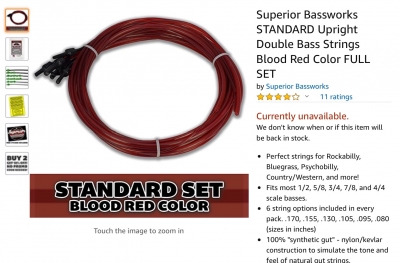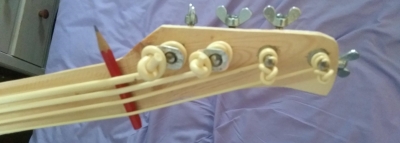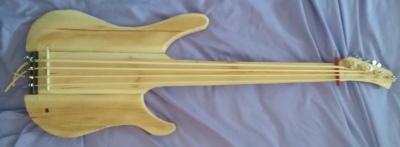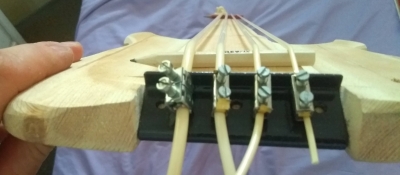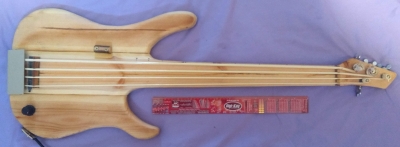Welcome to our forum. A Message To Our New and Prospective Members . Check out our Forum Rules. Lets keep this forum an enjoyable place to visit.
Currently working on errors from the latest (SimplePress) forum update. Many issues have been resoled and others are being worked on. Thank you for your patience.
 Topic RSS
Topic RSS



 (2 votes)
(2 votes) Regulars


Last year, I made a solid electric violin to take the pressure off my elderly German acoustic fiddle while I was in the clumsy stages of learning. It has been successful and a joy to play; I became so intent on learning violin that I completely ignored my guitars.
This year's summer project is something which has a fingerboard (no frets) and has a range from E1 upwards on four strings. It's not a double bass; it cannot sensibly be bowed, so discussion is banished to the breakroom. I'm building a solid, electric, bass ukulele using lessons learned from the violin project and ideas from Internet research.
You may have seen these diminutive basses: they look like other ukuleles, but sound like an upright acoustic double bass. They are played in the same way as an electric bass (cf "Fender Precision Bass", "Rickenbacker 4000" etc), and have become very popular. The prime brand for these is Kala and they are available in acoustic and solid versions.
I've owned Precision Bass (aka 'P-Bass') type instruments before, and so know the required characteristics. The electronics and transducers are also familiar and the woodwork is fun; I'm using more of the same pine bedstead which produced the two previous summer project instrument, the semi-acoustic guitar and the solid violin.
The finish will be shellac French polish to show-off the grain of the pine. I've chosen Aquila Thundergut polymer rubber strings as these appear to be the most favoured in low-tension applications (I have no truss-rod in my neck). As usual, the main woodworking tool so far has been my trusty Bosch hand-grinder with a coarse sanding disk. I have now a small bag of wood flour and a basic shape for the bass.
I still practice violin every morning for around an hour, and it's become may favourite instrument but I wanted something to add to give a bit of bottom for home-brewed backing accompaniment tracks. It's going to be a lot of fun.
If anyone is interested, I will provide more detail on the design and share some photos.
Peter
"It is vain to do with more that which can be done with less" - William of Ockham
"A crown is merely a hat that lets the rain in" - Frederick the Great
Regulars
 Offline
Offline

@peter et al. Where to begin.
First, please continue to post about this project.
Regarding the strings. Please also consider using “weed wacker” strings (kevlar core nylon). Unfortunately, unless you use products repurposed for string bass strings, each diameter will have a different color. This may give a unintended clown appearance.
Tim Dueinck did a cello with 1/2” thick styrofoam top and bottom plates, and found it to have good tone and was very loud. If you intend to be careful with the instrument, this may be a fun experiment for you.
I am currently researching making instruments with epoxy infused cloth. I intend to use silk cloth, since I got a deal on some beautiful material of that type. Blackbird Guitars makes some nice (to my ears) instruments using flax cloth. They also make ukuleles using the same process (using the brand designation ekoa).
Success is the progressive realisation of a worthy ideal. —Earl Nightingale.
Regulars


Thanks for the interest, @Irv.
I may experiment with other strings once the instrument has been played-in; there's a world of difference between the polyurethane U-bass strings I've purchased and the round-wound alternatives available. I don't anticipate bowing: the fingerboard radius is 12".
I have not intended to make the bass an acoustic instrument; as always, I cherish my relationship with family and neighbours. The other great advantages of a solid are reduced size and increased ruggedness. It is also very comfortable, having similar belly and forearm bevels as found on Fender basses. The lack of frets was intentional; I've learned to intonate a violin, so finding my way around a fretless bass should not be too traumatic.
Here's an image of the little beast, roughed-out and ready for fettling before being fitted out with machines, nut, piezo bridge (homebrew, of course) and a simple and effective tailpiece. The strings enter the tailpiece at 45 degrees, having traversed the bridge which is set at 22.5 degrees, shadowing the practice of acoustic viol-family lutherie. The entire bass is just 780 mm long (a shade over 30") and has the same scale length as a 1/4-size cello:
Peter
"It is vain to do with more that which can be done with less" - William of Ockham
"A crown is merely a hat that lets the rain in" - Frederick the Great
Regulars
 Offline
Offline

@peter . A clarification: the weed eater bass strings are intended to be plucked.
I believe a string bass is tuned to 4ths. Does this transfer to the bass guitar/ukulele as well?
Technical points. Do you think that an unaided pine neck will carry the strain of the strings? I have seen small plastic cubes with multiple drilled holes used to secure classical guitar strings against a bridge. You might be able to secure these strings in a similar manner. A US distributor of richlite gave me a couple of fingerboard blank samples. Too expensive for me to ship them to you but you might be able to score similar if there is a corresponding distributor in your neck of the woods.
Success is the progressive realisation of a worthy ideal. —Earl Nightingale.
Regulars


.@Irv ,
I took the trouble to run an experiment on a second piece of pine, using the bottom four (EADG) from my last restring on one of the guitars. These are well-worn Ernie Ball Super Slinkies. The pine is more than up to the task and the Aquila bass strings are reported to be a low tension item.
Basses, whether upright, electric or ukulele ('U-bass') are all tuned in fourths, E1 A1 D2 G2. As a guitarist, this is a familiar place and as a violinist, finding the intonation points might not be as fraught as it could be.
The tailpiece hooks over the back of the main pine plank and I am using the terminal cages from surplus electrical terminal blocks to secure the strings behind. They have two screws which are isolated from the strings (cables) by a strip of thin brass. I tighten the rearmost screw more aggressively, creating a graded and secure grip. This arrangement allows me to pretension the strings, thus saving turns around the tuning machine posts. Future photos will provide a visual exegesis.
There is a European material called Corene which is supposed to be a good alternative to ebony; they don't declare how this composite is made, but I'm guessing my bamboo coffee-cup fingerboard on the solid violin is very similar. The bass will rely on the shellaced pine surface initially; I don't expect much impact from the polyurethane strings but I'm prepared to cut it back and fit a piece of rosewood or hard maple if necessary.
Peter
"It is vain to do with more that which can be done with less" - William of Ockham
"A crown is merely a hat that lets the rain in" - Frederick the Great
Regulars
 Offline
Offline





One day I will make a lap steel guitar from a plank, but I'm not sure how many strings it should have. I suppose tuners and pickups dictate 3 or 6, so 3 it will be for my first attempt. It's a mistake to think it's a harmony instrument - it's a melody instrument and chords rarely require more than 2 notes.
Andrew
Verified human - the ignominy!
Regulars
 Offline
Offline






Regulars


Gordon Shumway said
One day I will make a lap steel guitar from a plank, but I'm not sure how many strings it should have. I suppose tuners and pickups dictate 3 or 6. It's a mistake to think it's a harmony instrument - it's a melody instrument and chords rarely require more than 2 notes.
There's nothing wrong with redundancy in pickups; use as many strings as you need. My four-string oddball 'lower two thirds' guitar uses a six-pole single-coil pickup, with the B and E poles sitting idle. Keef of the Stones routinely removes his E2 string when tuned to open G; saves having to mute a string you never play.
A second-user scaffold plank would make a funy starting-point; just cut it to length and shape it to taste with a fresh 40-grit sanding disc. Are they dulcimer-tuned?
Peter
"It is vain to do with more that which can be done with less" - William of Ockham
"A crown is merely a hat that lets the rain in" - Frederick the Great
Regulars
 Offline
Offline





Regulars
 Offline
Offline








Regulars


ELCB said
...I miss working with hand tools... UGH! UGH! (gorilla grunts from "Tool Time", comedy TV series).
- Emily
So, what's stopping you from rolling up your sleeves?
For me, it's the only way. I like to make things which suit me. The bass needs to be lightweight and compact. A Fender Precision weighs nine pounds and I suffer from back and knee damage; my bass weighs a fraction of that. My last P-bass was disposed of over a decade ago. It's the same deal with my treble guitars: my favourite is a home-made semi-acoustic; I have a Chinese Les Paul, but that weighs too much and I only play it sitting down. I have a Tanglewood Falcon (a Strat copy) in bits awaiting refurbishment and I guess that'll be another sit-down job once it's playable.
I also play violin while seated, to the annoyance of my teacher.
Peter
"It is vain to do with more that which can be done with less" - William of Ockham
"A crown is merely a hat that lets the rain in" - Frederick the Great
Regulars
 Offline
Offline

@peter . Since both your and my string selections are without metal, a piezo pickup is the only option, correct?
I wonder if a magnum version of the technique used to tie classical guitar strings could be utilized to avoid point compression of the string material?
Success is the progressive realisation of a worthy ideal. —Earl Nightingale.
Regulars
 Offline
Offline








 Thank you SO much Peter - I really appreciate that you care enough to share and I can always use the pep talk!
Thank you SO much Peter - I really appreciate that you care enough to share and I can always use the pep talk!
Not quite ready to get back in my workshop, yet - still not in shape for the major surgery I need, but workin' on it. Right now it's a huge deal for me to do some physical therapy, interact with the Grandkids, play/learn the violin and I'm so glad I've felt well enough these past few months for the FM Forum.
So, for the moment, I'm very happy to watch you!
 - Emily
- Emily
Regulars


Irv said
@peter . Since both your and my string selections are without metal, a piezo pickup is the only option, correct?I wonder if a magnum version of the technique used to tie classical guitar strings could be utilized to avoid point compression of the string material?
@Irv - Yes, piezo wafers are the order of the day, sitting under the bridge.
As you can see in the photos below, I do indeed use a knot to secure the strings - at the machines. They're too fat to trap under themselves, so I have tied a figure of eight knot in each end to stop them unreeving through the machine post holes. Possibly, this marine stopper knot has a different name in the western colonies.
Anywayup, I needed a proof of concept, and so I jury-rigged the strings over two pencils to pass as bridge and nut. The little beast tunes up and plays, and so I can proceed with more confidence. I have a lot of sanding ahead of me; the electronics are ready to install (the small hole is the place for the volume knob), including the components for a bespoke 1/4" socket (glued-in sleeve, brass tip contact and a tiny microswitch for amplifier power).
Notwithstanding the pencils, what you see is by and large what it will finish up as; including the odd placement of the G tuning post. I wondered while I was thicknessing the headstock why I had left it so long, and forgot about the shape of the tuning machine backplates. I haven't the stomach nor the need to extend the woodwork. The D and G holes had to be bored out to 2.5 and 3 mm respectively, and the E and A machines have special top plates for securing the strings.
Edit - It was too much to bear; I removed the last (G) tuning machine and put it on the underside of the head opposite the E and A machines. You'll see the result in future posts; the modification has shortened the bass by another inch. Holding it under the chin like a fiddle, it doesn't feel much bigger than a viola. Tomorrow morning, I'll make a nut and a bridge from a piece of holly wood (I trimmed our big holly last year and kept the better pieces) and then try not to get too many splinters playing it. I'll also make a guard to cover the tailpiece and fold the spare ends of the strings under the body.
Peter
"It is vain to do with more that which can be done with less" - William of Ockham
"A crown is merely a hat that lets the rain in" - Frederick the Great
Regulars
 Offline
Offline

@peter . Regarding splinters. I damaged a cello painted fingerboard by heating it too much once (I needed to remove the fingerboard to work on the neck). I sprayed fingerboard with mat black spray paint and applied paste wax after the paint set up for about 5 minutes. I worked the wax into the paint with fast scrubbing with crumpled newsprint. It created a very hard and serviceable surface.
Success is the progressive realisation of a worthy ideal. —Earl Nightingale.
Regulars


Good work, @Irv .
I plan to keep the natural pine showing through either poyurethane lacquer or French polish; the rubber strings are very kind to the playing surface: they work well against the raw, unsanded pine itself. Yes, I've been playing the little beastie.
I've realised an added benefit of a fretless project - it doesn't matter about scale length, or even position relative to the hardware. It is what it is, and it plays anyway. I could have swung the nut and bridge to attain 'just intonation', but it matters not. It plays, and well.
Peter
"It is vain to do with more that which can be done with less" - William of Ockham
"A crown is merely a hat that lets the rain in" - Frederick the Great
Regulars


An update on the Beastie:
I've been playing the little bass for the last couple of nights, and I'm satisfied with the feel and sound, however:
(1) The fingertips need to be lubricated before playing to prevent the awkward pops and squeals which dry polyurethane strings suffer from. No biggie, I use a little coconut oil.
(2) The G tuning machine sticks out like a sore thumb; when I have time (!) I'll cut the top off, turn the remains of the shaft parallel, put an M5 die over it and Loctite another M5 wingnut on to it.
(3) The thumb-rest is a little twee; I may increase its length to aid playability. Like the nut and bridge, it's made of holly wood.
I'm very pleased with the simple lines and uncluttered fingerboard. The other big benefit of the materials and scale is the weight: at 2 lb 11 oz (1220 gm) it's a third of the weight of a Fender Precision.
Peter
"It is vain to do with more that which can be done with less" - William of Ockham
"A crown is merely a hat that lets the rain in" - Frederick the Great
Regulars


Irv said
@peter , please provide a view of the back of the peg stock. I am interested in learning how you translated the direction of motion on your diy tuners.
@Irv , the tuners are standard, cheap worm & wheel treble guitar items salvaged from a Korean Strat copy; the original plastic knobs fell apart and had to be replaced with M5 wingnuts pressed onto the flatted ends and epoxied in place for security. The wingnuts have a pleasantly heavy galvanised finish. The D and G tuner posts had their string holes opened out to closely match the 2.5 and 3.2 mm diameters of the strings, and a regular 'over& under' pinch has secured the string ends. The E and A strings are far too large for this to be an option, and so I prepared a pair of devices to accomodate them; I removed the brass bushing core from two surplus control panel knobs (1/4" shaft) and pressed them into heavily-modified M8 copper tube lugs (for terminating heavy cables to threaded posts) and soft-soldered them for added security.
The tuner posts run in plain steel bearings set into the upper surface of the headstock; they were made by drilling out M6 hankbushes and pressed into the wood, supported by epoxy adhesive.
The original four-in-line layout was chosen to echo the Fender basses, but a marking-out error meant the G tuner had to be fitted at the end of the stock. This looked and felt horrible, so I opted to move it down to its present location. Unlike the weird arrangement Fender adopted (headstock parallel to fretboard), I've canted the headstock back to afford correct string angle over the nut. I don't know the history of why Leo Fender cut his necks that way (necessitating 'string trees' to pull some of the strings into order), but I'll bet it was cost. You need thicker neck lumber to achieve the angled stock, or use a scarf joint (as I did). I guess Mr Fender got 50% more neck from each batch of maple, and no fancy jointing, but we've all had to endure those afterthought devices, the string trees.
I will provide photographs to support all this this evening (Greenwich time).
Peter
"It is vain to do with more that which can be done with less" - William of Ockham
"A crown is merely a hat that lets the rain in" - Frederick the Great
1 Guest(s)


 Log In
Log In Register
Register










